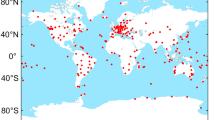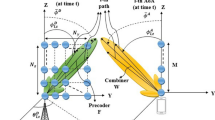Abstract
In this paper, the issue of joint angle estimation for bistatic multiple-input multiple-output (MIMO) radar is investigated, and an algorithm for the joint estimation under real-valued computation is proposed. By utilizing the unitary transformation, the direction matrices and the data matrix are transformed to be real-valued ones. The direction of departure (DOD) can be estimated via the real-valued rotational invariance in the subspace, and the direction of arrival (DOA) can be obtained via the real-valued reduced-dimension function of multiple signal classification (MUSIC). The proposed algorithm utilizes both the signal and noise subspaces, requires no peak searching, and can achieve automatically paired estimations of the angles. Furthermore, it has better angle estimation performance than some existing methods. The simulation results verify the algorithmic effectiveness and robustness of the proposed algorithm.









Similar content being viewed by others
References
M.L. Bencheikh, Y. Wang, Joint DOD-DOA estimation using combined ESPRIT-MUSIC approach in MIMO radar. Electron. Lett. 46(15), 1081–1083 (2010)
M.L. Bencheikh, Y.D. Wang, H.Y. He, Polynomial root finding technique for joint DOA DOD estimation in bistatic MIMO radar. Signal Process. 90(9), 2723–2730 (2010)
R. Bro, N.D. Sidiropoulos, G.B. Giannakis, A fast least squares algorithm for separating trilinear mixtures, in Proc. Inter. Workshop ICA and BSS, France, Jan. (1999), pp. 289–294
D.F. Chen, B.X. Chen, G.D. Qin, Angle estimation using ESPRIT in MIMO radar. Electron. Lett. 44(12), 770–771 (2008)
J. Chen, H. Gu, W. Su, Angle estimation using ESPRIT without pairing in MIMO radar. Electron. Lett. 44(24), 1422–1423 (2008)
E. Fishler, A. Haimovich, R.S. Blum, et al., MIMO radar: an idea whose time has come, in Proc. IEEE Radar Conf., Apr. (2004), pp. 71–78
X. Gao, X. Zhang, G. Feng, Z. Wang, D. Xu, On the MUSIC-derived approaches of angle estimation for bistatic MIMO radar, in 2009 International Conf. Wire. Networks and Inf. Syst. (WNIS ’09), Shanghai, China, Dec. 28–29 (2009), pp. 343–346
M. Haardt, J.A. Nossek, Unitary ESPRIT: how to obtain increased estimation accuracy with a reduced computational burden. IEEE Trans. Signal Process. 43(5), 1232–1242 (1995)
J. Li, P. Stoica, MIMO radar—diversity means superiority, in Proc. 14th Adaptive Sensor Array Process. Workshop (ASAP ’06), Lincoln Lab, MA, USA, Dec. (2006), pp. 1–6
X. Li, Z. Zhang, W. Mao et al., A study of frequency diversity MIMO radar beamforming, in IEEE 10th International Conference (ICSP2010) (2010), pp. 352–356
I. Marcu, S. Halunga, O. Fratu, D. Vizireanu, Multiuser systems implementations in fading environments, in Applications of MATLAB in Science and Engineering, ed. by T. Michałowski, September 9 (InTech, Rijeka, 2011), pp. 167–180. ISBN 978-953-307-708-6
D. Nion, N.D. Sidiropoulos, A PARAFAC-based technique for detection and localization of multiple targets in a MIMO radar system, in 2009 IEEE International Conference on Acoustics, Speech and Signal Processing, Apr. (2009), pp. 2077–2080
D. Nion, N.D. Sidiropoulos, Adaptive algorithms to track the PARAFAC decomposition of a third-order tensor. IEEE Trans. Signal Process. 57(6), 2299–2310 (2009)
B.D. Rao, K.V.S. Hari, Performance analysis of ESPRIT and TAM in determining the direction of arrival of plane waves in noise. IEEE Trans. Acoust. Speech Signal Process. 40(12), 1990–1995 (1989)
P. Stoica, A. Nehorai, Performance study of conditional and unconditional direction-of-arrival estimation. IEEE Trans. Signal Process. 38(10), 1783–1795 (1990)
P. Stoica, A. Nehorai, Performance comparison of subspace rotation and MUSIC methods for direction estimation. IEEE Trans. Signal Process. 39(2), 446–453 (1991)
C. Voicu, S. Halunga, D. Vizireanu, Performances of conventional and MMSE detectors for image transmissions, in Telecommunication in Modern Satellite Cable and Broadcasting Services (TELSIKS). 10th Intern. Conf., vol. 1, 5–8 Oct. (2011), pp. 76–79
H. Yan, J. Li, G. Liao, Multitarget identification and localization using bistatic MIMO radar systems. EURASIP J. Adv. Signal Process., 283483 (2008), pp. 1–8
C. Yunhe, Joint estimation of angle and Doppler frequency for bistatic MIMO radar. Electron. Lett. 46(2), 170–172 (2010)
X. Zhang, D. Xu, Angle estimation in MIMO radar using reduced-dimension capon. Electron. Lett. 46(12), 860–861 (2010)
X. Zhang, L. Xu, L. Xu, D. Xu, Direction of departure (DOD) and direction of arrival (DOA) estimation in MIMO radar with reduced-dimension MUSIC. IEEE Commun. Lett. 14(12), 1161–1163 (2010)
X. Zhang, Z. Xu, L. Xu, D. Xu, Trilinear decomposition-based transmit angle and receive angle estimation for multiple-input multiple-output radar. IET Radar Sonar Navig. 5(6), 626–631 (2011)
G. Zheng, B. Chen, M. Yang, Unitary ESPRIT algorithm for bistatic MIMO radar. Electron. Lett. 48(3), 179–181 (2012)
Z.D. Zheng, J.Y. Zhang, Fast method for multi-target localization in bistatic MIMO radar. Electron. Lett. 47(2), 138–139 (2011)
M.D. Zoltowski, M. Haardt, C.P. Mathews, Closed-form 2-D angle estimation with rectangular arrays in element space or beamspace via unitary ESPRIT. IEEE Trans. Signal Process. 44(2), 316–328 (1996)
Acknowledgements
This work is supported by China NSF Grants (61201208, 61271327, 61071164), Jiangsu Planned Projects for Postdoctoral Research Funds (1201039C), the China Postdoctoral Science Foundation (2012M521099), the Hubei Key Laboratory of Intelligent Wire1ess Communications (IWC2012002), the Open project of the Key Laboratory of Nondestructive Testing (Nanchang Hangkong University), the Aeronautical Science Foundation of China (20120152001), the Qing Lan Project, Research Innovation Program for College Graduates of Jiangsu Province (CXZZ13_0165), Funding for Outstanding Doctoral Dissertation in NUAA (BCXJ13-09), PAPD of Jiangsu Higher Education Institutions, and the Fundamental Research Funds for the Central Universities (NS2013024, NZ2012010, kfjj120115, kfjj20110215).
Author information
Authors and Affiliations
Corresponding author
Appendix
Appendix
Define h t=−angle(a r (ϕ k )), which contains the ambiguous phases. Set the initial elements of h as zeros. The unambiguous phases can be identified via the following two steps [19].
-
1.
Set the first element: h(1)=0.
-
2.
h(n+1)=h(n)+δ(n),n=1,…,N−1 where
$$ \delta ( n ) = \left \{ \begin{array}{l@{\quad}l} \mathbf{h}^{t} ( n + 1 ) - \mathbf{h}^{t} ( n ) & \bigl\vert \mathbf{h}^{t} ( n + 1 ) - \mathbf{h}^{t} ( n ) \bigr\vert \le \pi\\ \mathbf{h}^{t} ( n + 1 ) - \mathbf{h}^{t} ( n ) - 2\pi & \mathbf{h}^{t} ( n + 1 ) - \mathbf{h}^{t} ( n ) > \pi \\ \mathbf{h}^{t} ( n + 1 ) - \mathbf{h}^{t} ( n ) + 2\pi & \mathbf{h}^{t} ( n + 1 ) - \mathbf{h}^{t} ( n ) < \pi \end{array} \right .$$
Rights and permissions
About this article
Cite this article
Li, J., Zhang, X. Unitary Subspace-Based Method for Angle Estimation in Bistatic MIMO Radar. Circuits Syst Signal Process 33, 501–513 (2014). https://doi.org/10.1007/s00034-013-9653-9
Received:
Revised:
Published:
Issue Date:
DOI: https://doi.org/10.1007/s00034-013-9653-9




